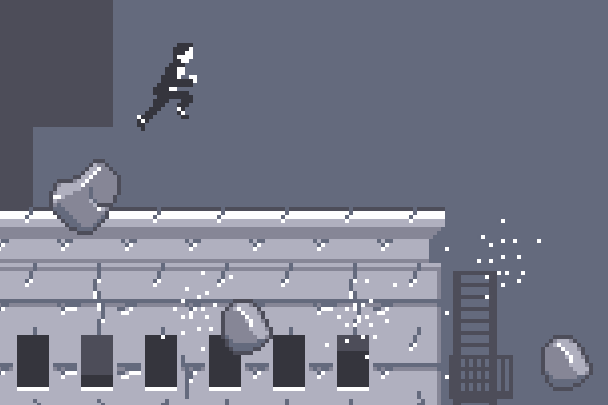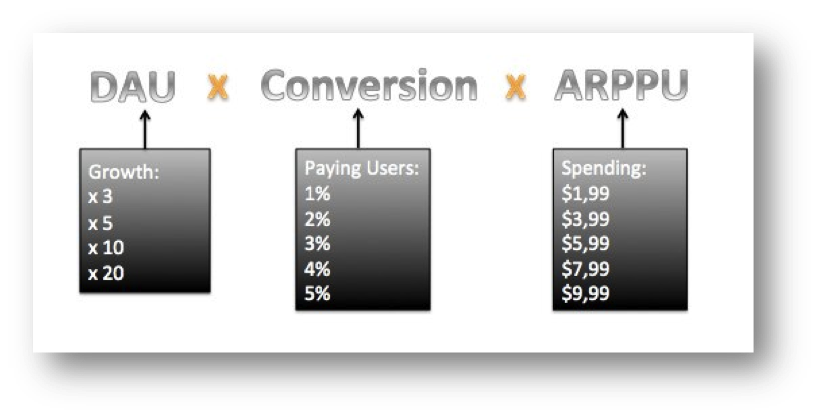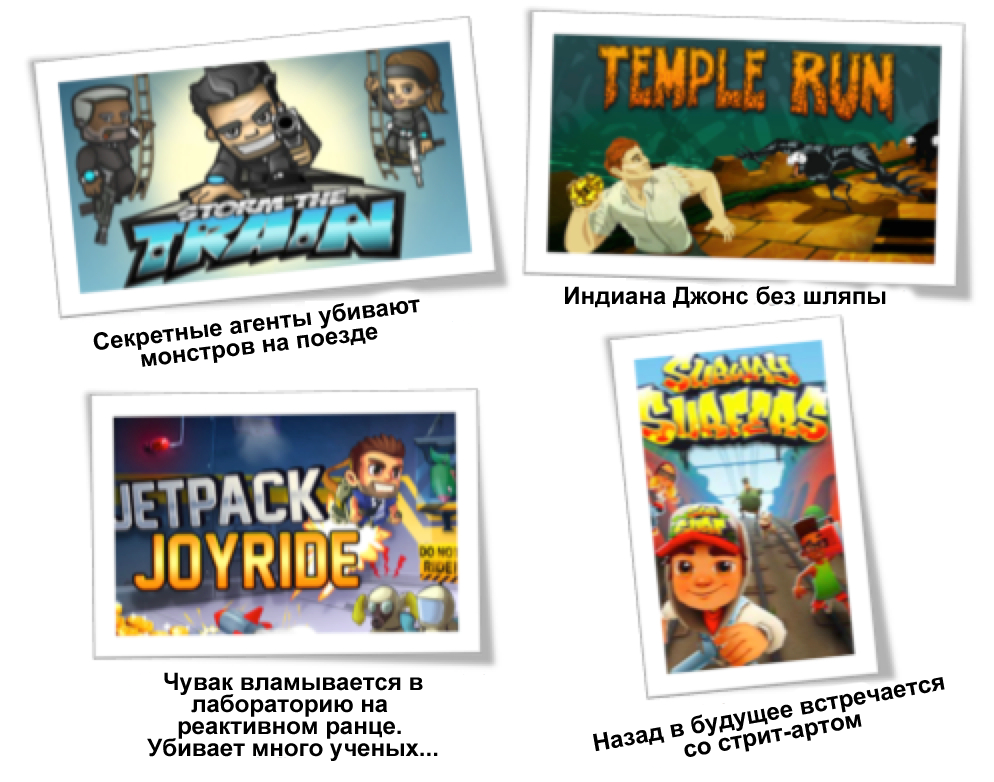Endless Runner: secrets of monetization
Mikhail Katkoff in his blog told what the developers of endless runners should pay attention to first of all. We have translated and supplemented his text a little.
Imagine a game in which the main character runs, avoiding constant obstacles. How far he runs depends on how much the player will get virtual currency and points. The currency allows the user to improve the characteristics and decorate his protagonist. It works primarily for the player. Earned points add a social aspect. You can brag about the result in the standings in front of your friends.

Considering that infinite runners are not strongly tied to content, they can be called a “dream come true.” Such projects do not bother users, moreover, they like them madly. For example, Temple Run from Imangi Studios has been downloaded more than 170 million times. Its sequel Temple Run 2 most recently topped the US box office iOS top.
There are also Subway Surfers from Kiloo. The game was launched in May 2012 and since then, receiving one or two updates a month, it also demonstrates excellent box office performance.
Jetpack Joyride from Halfbrick Studios is an equally worthy example. The game did not achieve such significant monetary results, but it is considered an exemplary project, it has many fans, both among ordinary players and developers.
A small digression. The genre itself, to which I tend to classify both 2-dimensional and 3-dimensional infinite projects, arose in 2009, when Adam Saltsman’s game Canabalt was released.

But the genre became widespread in the mobile environment after the releases of the already mentioned Jetpack Joyride and Temple Run. It is clear that the success of mechanics caused a wave of ideological heirs and imitations, and after that serious competition. Someone manages to survive in this race, someone, like my personal favorite – Storm the Train, does not.
Ruining monetization
As already mentioned, runners are not as dependent on new content as farms. In this regard, they are ideal for F2P. Costs, let’s say, are falling. As for the type of monetization itself, the revenue from f2p projects mainly depends on the number of active players, the percentage of payers (conversions) and the average size of one purchase.

The active player base consists of new users and those whom you were able to retain. There are several variables that affect their total number: user acquisition, feature acquisition, cross-promotion, and so on. But in this post I will talk about two things that are especially important for DAU: setting and management.
I will not talk about ARPPU, as it differs little between projects and is very low. Instead, I will focus your attention on how well these games are doing in creating demand, which, as we know, is what makes players start paying.
Setting
The setting or theme of your application is an extremely important and, unfortunately, underestimated by many. Moreover, its role in modern markets, where, literally, there is no respite from free applications, is growing significantly. Why is the setting so important?

As a gamer, I’m more impressed with what’s on the left, as a designer I have to stick to what’s on the right
Firstly, it helps you get those very downloads.
Think about it. You stumble upon a free pirate game in the App Store and immediately a logical chain appears in your imagination somewhere on a subconscious level: pirates, ships, guns, treasures, parrots and so on.
Secondly, a good theme will simplify game design and thereby help increase the level of user retention. In the sense that in a pirate game you don’t have to explain what the player needs to do. They are already ready to set sail, fight at sea and engage in robbery.
The theme is something in which we, developers of iOS and Android games, as a rule, miss big. We too often try to make a game that we would love to play ourselves, even if in real life we play more on PCs and consoles. So it turns out that instead of making a game that we would like to play, we are developing a project “that we would play if we didn’t have a PC or console.”
But sometimes the topic, as they say, “hits the bull’s-eye.” Most often this happens when we combine our childhood memories, our nostalgia for our favorite games with what we do, we invest a little more in the game. The Clash of Clans universe may remind you of the fantasy worlds of Zelda, Gauntlet, or even the Lord of the Rings.
Success in choosing the right setting can also wait if, when developing a project, you think about your family, create a game for them, try to make it like them. In this case, you can get a cool game, even if there are no guns, dragons and robots in it.
Management
You might think that every developer uses a large, beautiful, touch screen in full. But this is not the case. Sometimes we get so carried away with developing a game “that we would like to play ourselves” that it all ends up with setting up virtual joysticks and buttons. But this is not the way out. Not all users are nostalgic for the good old NES games. The funny thing is that it is on such a hardcore audience that it is most difficult to make money. She is hostile to the IAP, considering it cheating. 
So from the very beginning, it is necessary to focus on swipes, intuitive interactions with the screen when developing. Also try to make it so that you can play with one hand. This way the user will be able to interact with your application on the go.
Progress
The progress that is noticeable is what sells the F2P game. When entering the game, you allow the user to achieve tangible results for him, and then significantly reduce the growth rate (the first example that comes to mind is the accumulation of experience in any role–playing game: to reach the second or third level, it is enough to kill a couple of rats, but to overcome the hundredth, you need to kill a dozen dragons). A user who is used to rapid progress and guided by the tasks that the game puts in front of him will want to spend money on speeding it up.

In fact, in the case of infinite runners, everything is as simple as possible – they are all clones. In each of them, the user earns soft currency, which is used to raise the player’s attributes or open new characters.
Competition
You can create a demand for progress, not only by demonstrating game locations, new characters or any bonuses. To do this, it is enough to evoke a “competitive spirit” in him. And it’s not just about the glasses, but also how and when they are shown to you.

During the game and at the end of each match? Wow, then you will probably have a stubborn confrontation, a struggle for a place in the standings. And this battle can result not only in a few hours, but also in several hundred rubles.
Advertisement
Considering that in other cases less than 1% of players invest money in the game, we have to come up with ways to make money on those who never pay at all.
And one of the most reliable ways is advertising.
Just don’t turn your game into a Christmas tree. Select one or two screens and place ads there. You can also think about placing a wall of offers where you can reward users with in-game currency for viewing ads.

Advertising in Subway Surfers occurs once per session, but brings decently
Despite the fact that most of the endless runners are F2P projects, it is difficult for them to get in and then hold their positions in the box office tops.
This is largely due to the fact that none of them has any limitations in mechanics. The energy is not running out, there is no timer.
Usually game developers say that people hate restrictions of this kind, and they are right. But the following metaphor will do here: after eating a piece of delicious pie today, you will want another one tomorrow. But if you eat the whole pie today, you are unlikely to want it tomorrow.
Look at your game like a delicious pie. Offer some part of it to the user, but not the whole. In the latter case, you will overfeed him.